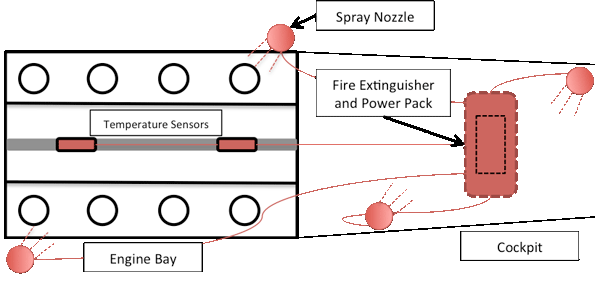Fire Suppression Systems In Formula 1 Cars
by Julian Weathersby, Clemson Automotive Engineering Graduate Student
- Basic Description
-
Formula 1 cars are some of the most technologically advanced machines on the planet. They are capable of averaging speeds of 180 mph on the most demanding circuits, while engine speeds hover around 18000 rpm during the race. With new rules preventing cars from refueling during race, carrying the added fuel increases the risk of fires during crashes. According to the Federation Internationale de l' Automobile, FIA, regulations, all Formula 1 cars must me equipped with an automatic fire suppression systems which will discharge into the cockpit and engine department. Additionally, 95% of its components must discharge between 10 and 30 seconds. Additionally, an activation switch should be easily accessible by the driver whilst in the cockpit and also via a switch located on the outside of the vehicle by a marshal.
This system is considered active fire protection because it is activated in the event of a fire and does not aid in preventing the fire. The fire suppression system has its own power system to ensure functionality in the event that the car loses power or power supply is cut. The system monitors the engine and cockpit temperatures with a temperature sensor, typically by way of temperature wires. In the event that the temperature surpasses the sensor’s critical temperature (about 125 degrees Centigrade) or experiences a sudden sharp rise in temperature, the system will activate and an Aqueous Film Forming Foam (AFFF) will be ejected into the engine bay and cockpit, preventing a fire from getting out of control. If the system is manually activated by the driver or a marshal, power is completely cut off to the vehicle and the system is simultaneously activated.

It is not uncommon for F1 technology to be passed down to road cars, such as carbon fiber and KERS, Kinetic Energy Recovery System. Active fire suppression systems are not exclusive to Formula 1. Independent manufacturers develop the systems and their products are also available for road cars. The use of AFFF is not desirable for road cars because it can not be operated below 20 degree Centigrade, which is well below any low temperature experience in F1, however, road cars need to be able to work in lower temperatures. Powder extinguishers are desirable for road cars because of their efficiency in putting out burning fuel or oil.
- Sensors
- temperature
- Actuators
- Fire Extinguisher
- Manufacturers
- Lifeline Fire & Safety Systems, SPA Design UK,
- For More Information
- [1] Safety Equipment, Formula1.com.
- [2] Active fire protection, Wikipedia.
- [3] Fire extinguisher, f1technical.net, April 12, 2006.
- [4] Burning Issues, Allianz, gp-world.net.
|

